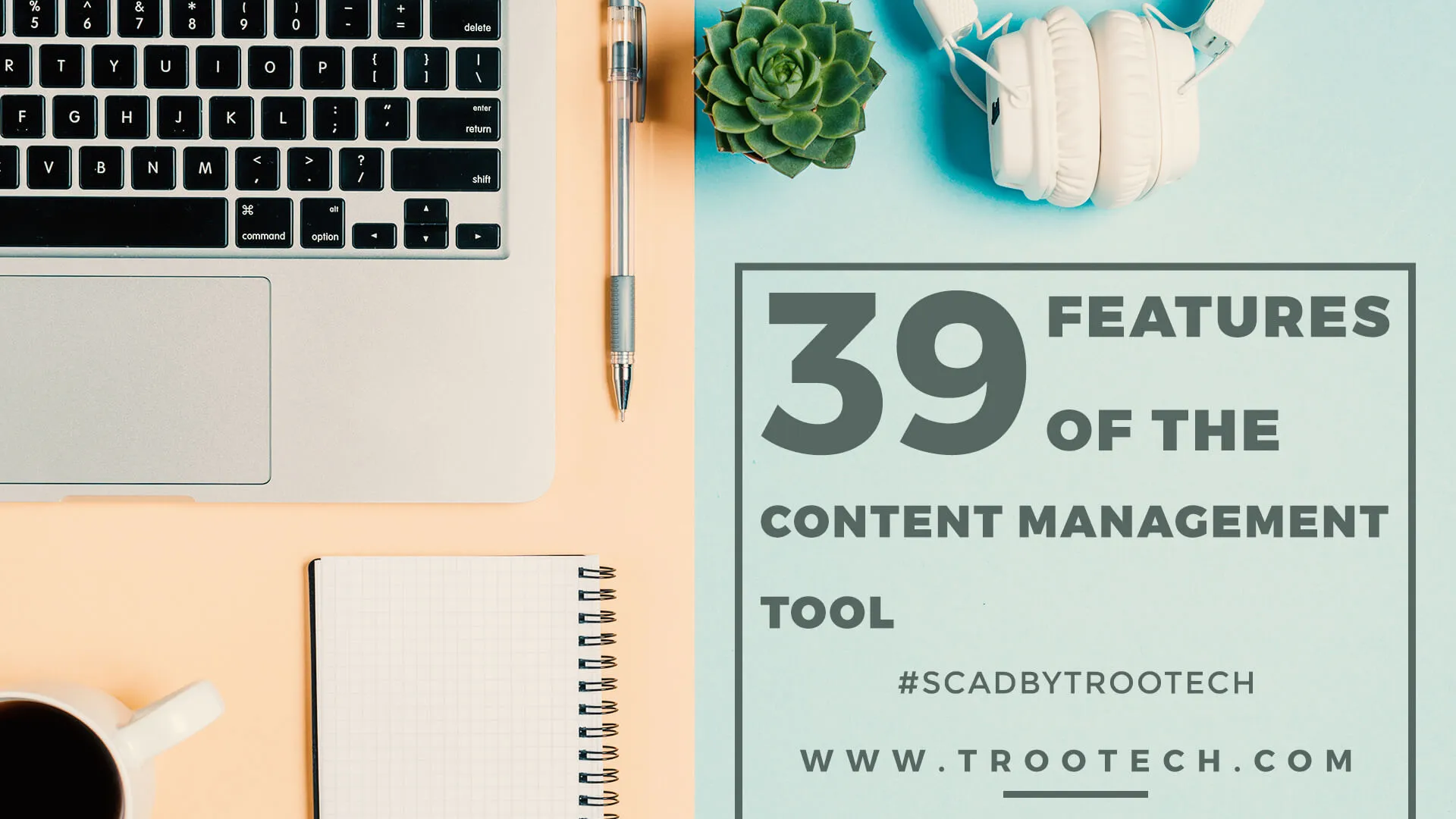39 Must Have Features of The Content Management Tool for the Media Agencies

A normal day in a Media Agency without using the features of the content management tool goes like this:
Step 1:
The researchers collect the latest information and store it.
Step 2:
The information is then passed on to the creative heads who think of ways to utilize the information.
Step 3:
The information along with the necessary instructions is passed on to the content writers.
Step 4:
The required media that would go along with the created content piece is thought upon by the content writers.
Step 5:
The information is then transferred to the Graphic Designers and the required content developers along with the necessary information.
Step 6:
The entire content piece is assembled and reviewed by the editor. If there is any edit needed, it goes back to the designated step for the required rework.
Step 7:
The content is given to the publishers along with the necessary scheduling instructions for publishing it.
Step 8:
On the basis of the type of the platform and the schedule, the publishers exhaust the content and track it.
All this work and all they have to deal with is manual processes
A plenty of agonies which highly go overlooked by the commoners are dealt with, by the media agencies every dawn and dusk, repeatedly.
But who cares?

Chronicles of Manual-working Problems Suffered by the Media Agency
►The content is scattered throughout the media organization with the Content developers, Writers, Graphic designers, Editors, Publishers which many a times, results in the creation of the similar or duplicate content.
►The content is duplicated in multiple documents, making it extremely difficult to find and precisely update all replicated content.
►The editors have to rely on the manual processes to refer/ask for the content and a lot of time is exhausted while other priority tasks suffer.
► The content developers along with the writers and editors seem quite accustomed with the existing XML editing tools. Thus, they may be reluctant to get habituated with another app or software.
►The manual content management system is exceedingly complicated and it requires a unique editorial process.
►There is no module where remote content contributors work from home or different office locations.
►There is no confidentiality for the content storage or management.
►Two or more than two people cannot work in the same document or file simultaneously.
Sigh!
Of course, the world is at an incomparable pace, all thanks to media companies.
But don’t you think it is the high time to return the favor in the form of exciting and helpful features of the content management tool?
Working in this direction, we have conceptualized a business idea which comes at rescue to the media companies. This approach compiles them to cull the manual processes.
The Idea Exposed
We think of a software which single-handedly eases out all the manual functions that are happening within the media agencies, right from the researchers to the publishers and the tracking team.
The software will be responsive and will be utilized on any device with authorized independence. Every stakeholder will have their personalized dashboards, logins, and accounts.
39 Most Stellar Features of the Content Management Tool to Compliment the Idea of Ease
.1) Registration
Each stakeholder will have their own accounts and dashboards which they can customize as per their requirement and ease.
.2) Personal Chat Module
The software will consist of a chat module which will enable the stakeholders to chat with the concerned operator, supported by the transfer of files, screen sharing, media, etc.
.3) Group Chat Module
The software will include the group chat module, broadcasts for enabling communication with the other stakeholders as well. This feature serves as one of the most important one in our list of features of the content management tool, owing to the necessity of communication that arises in every task.
.4) Raw Research Material Accumulation (Hourly)
The researchers add the latest data as and when they get them. This calls for a lot of replica within the research materials. Hence, when the researcher adds the data, the system checks for the existing replicas, if any, and if it is not found, only then the data can be stored.
.5) Instructions Lookup
For every content, there are certain precautions and certain care that has to be taken to make the content a hit. The researchers find their own sets of instructions for the content developers, the content writers have their own instructions for the graphic designers, and these instructions can be stored together.
.6) Edits
At any stage when the edit is required, it is stored in a single place and is reworked on. This one among the features of the content management tool is of importance when more than one person is working on a single article and requires edits and approval from the seniors.
.7) Guidelines and Checklists
The guidelines and checklist section consists of all the instructions to be strictly followed while working on the content creation. This can be helpful when one is stuck at a point in their designated work. The module also consists of a chat module which can be used to communicate with the problem supported by the doc/ media to the supervisor.
.8) Review
Once the content is ready at the end of the content writer, content developer, and content curator, the content is posted in the review section, which the editor has an access to, can suggest edits, or can directly forward it into the publish section.
.9) Publish
The publish section consists of all the contents that are to be posted on the website and other media sources along with the necessary instructions about the scheduling.
.10) Schedule to the Post
The software comes with a scheduler, which eases out the functioning of the publishers by allowing them to schedule the posts for publishing them on various Social Media Platforms and the parent website at the designated date, time, and the author specified.
.11) Sync in with Social Media Platforms
The social media platforms can be integrated within the software itself, so it becomes easy for the publishers to post the content from a single stop.
.12) Edit Date with Publication (Turn on or off)
When any edit is to be made in any publication, the feature allows to edit the date of the new content.
.13) Publication Analysis
The Publication Analysis feature allows to make the analysis about the published content, their sources, the channels they are posted to, etc.
.14) Single-source Functionality
Each part of the content is stored only one time in a single repository, enabling maximum content reuse and culling duplicate content.
.15) Research Links Bookmarked
The research links can be bookmarked by the researchers, can be stored and shared with the content creators, content developers, content writers, graphic designers, editors, evaluators, project managers, creative managers, and publishers.
.16) Publishing Content in Various Formats
When we define the features of the content management tool, we consider many aspects and one of them is the compatibility of content with various platforms. The content will be supported in different formats as PDF, doc file, etc.
.17) Content Reusability
This empowers to recycle the content across multiple documents without having to twin it and to have immediate access to the reused content.
.18) Bi-directional Link Management
The feature directly tracks the cross-referenced content that allows the users to automatically update all the information about a piece of content across all publications and prevent inaccurate content.
.19) Integrating with the Editing Tools
This tool can benefit the most to the editors. This will integrate all their current editing works in the real-time with the help of the editing tools in the software. With the help of the integration tool, it becomes important to get on board all the front stakeholders to the website.
The integration is done with the help of the editing tools and it can be used by the content curators, content developers, content writers, researchers, editors, graphic designers, publishers, assemblers, etc.
.20) Full Unicode Support
Not every content is the same, some might require another language, another symbol, another character for the publishing of the content. Hence, it becomes very crucial to build the full Unicode support that consists of unique character sets in the system.
.21) Multi-channel Publishing
The Multi-channel Publishing feature helps the content to be easily reused for publishing to the supported media formats to various Social Media Channels.
.22) Customization
Every user will have a different registration system, dashboard, and they can make customization to the functionalities which they require frequently.
.23) Filters
The users can make the searches based on the assigned metadata and description.
.24) Remote Access
Halfway through the features of the content management tool and we have one of the mandatory feature of remote access. The users who are at a remote location can access the system through a secure web interface.
.25) Authorized Access Control
The system administrator assigns user privileges and roles, allowing the users to only access the content they are authorized to use.
.26) Graphical Workflow
The heads of the graphic designers create a graphical workflow with instructions and email notifications to alert users of the project’s status and the execution.
.27) Global Change Capabilities
The designated users can change the content in one instance and automatically update it everywhere else it appears.
.28) Structural Flexibility
The users have the ability to change a data model and/or manage the multiple modules altogether without major changes to the system.
.29) Security Management
With so many content curators, content developers, graphic designers, editors, publishers, writers, content developers, etc., it is important that there is security concern that can be achieved by fully customizable content permissions, module permissions, and other user roles.
.30) Multi-site Support
Every website now works with different domains to efficiently be able to target a narrower audience and support their main website with the additional links and traffic. The multi-site support features helps to share the content across multiple sites and it becomes easy to manage the content from a single device.
.31) Support for the Mobile Devices
You cannot miss out this one from all the features of the content management tool, as currently mobile devices are the most important gadgets. While the work of the media agency is not limited with the in-house publications, it is important that the system also supports the mobile devices for providing the ease of accessibility.
.32) Admin Management on Multiple Levels
The admin management module of the content management tools will authorize to create a number of private and safe access accounts.
.33) Keep Reports and Logs
The keep reports and logs feature allows the users to maintain all the records and logs at a glance. This way the users can keep a track of all the payments, new users, daily sales and even of the graphs from the backend. The system will provide the users with hassle-free tactics to check the site’s earnings.
.34) Functional Search Engines
While searching for the documents can be one of the biggest headaches in the wrong document management software, the functional search engine makes it easy to search for the document, information, and text to quickly locate what is needed.
.35) Multimedia Content Storage
The software will have a document management system that can not only accommodate but also index, sort, store, and easily retrieve a variety of content when trying to maintain accurate and complete records.
.36) File Importing
The file importing feature can help to capture the electronic document from its location and the file it directly imported into the records system. Out of all the features of the content management tool, file importing is important and stands out as it is meant to be of frequent use.
.37) Easy Retrieval
Having a document management system should make locating files simple, no matter how much information is contained in a client record. This retrieval should make it possible to search and retrieve across multiple applications and from within your practice software. The feature also makes it possible to configure standard-search results to make retrieval smoother and faster.
.38) Mark as Done in Research Materials
The research materials that are exhausted are automatically marked as done by the content developers.
.39)Reliable Backup and Recovery
Any misplaced piece content, image, file, etc. can cost a lot of efforts and thus, it is important to have a reliable backup that ensures the recovery of the files quickly.
This was an inexhaustible list of the MUST-have features of the Content Management Tool for the Media Agency.
Follow Us On

